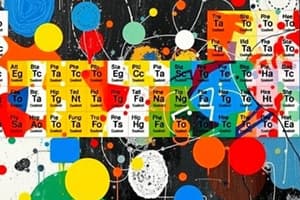Podcast
Questions and Answers
What is the primary distinction between cations and anions?
What is the primary distinction between cations and anions?
- Cations have a neutral charge, anions have a positive charge.
- Cations are positively charged, anions are negatively charged. (correct)
- Cations have additional electrons, anions have fewer electrons.
- Cations are formed by losing neutrons, anions by gaining protons.
Which of the following trends occurs as you move from left to right across a period in the periodic table?
Which of the following trends occurs as you move from left to right across a period in the periodic table?
- Atomic radius increases.
- Ionization energy decreases.
- Electronegativity increases. (correct)
- Electron affinity becomes less negative.
Why are radioactive isotopes often used in medical applications?
Why are radioactive isotopes often used in medical applications?
- They are stable and non-toxic to human tissue.
- They emit radiation that can be used for imaging or treatment. (correct)
- They have identical numbers of protons and electrons.
- They are less expensive than stable isotopes.
Which statement correctly describes the electron configuration of an atom?
Which statement correctly describes the electron configuration of an atom?
What happens to the atomic radius as you move down a group in the periodic table?
What happens to the atomic radius as you move down a group in the periodic table?
Flashcards are hidden until you start studying
Study Notes
Atomic Structure
- Atoms: Fundamental units of matter, consisting of protons, neutrons, and electrons.
- Nucleus: Central part of an atom containing protons and neutrons.
- Protons: Positively charged, determines atomic number.
- Neutrons: Neutral, contributes to atomic mass.
- Electrons: Negatively charged, orbit the nucleus in electron shells/energy levels.
- Electron Configuration: Distribution of electrons among orbitals; follows the Aufbau principle, Pauli exclusion principle, and Hund's rule.
- Ions: Atoms that have gained or lost electrons, resulting in overall charge (cations = positive, anions = negative).
Periodic Trends
- Periodic Law: Properties of elements are periodic functions of their atomic numbers.
- Trends:
- Atomic Radius: Decreases across a period (left to right), increases down a group.
- Ionization Energy: Energy required to remove an electron; increases across a period, decreases down a group.
- Electronegativity: Ability of an atom to attract electrons in a bond; increases across a period, decreases down a group.
- Electron Affinity: Energy change when an electron is added; generally becomes more negative across a period.
Isotope Applications
- Isotopes: Atoms of the same element with different numbers of neutrons (different masses).
- Types:
- Stable Isotopes: Do not undergo radioactive decay.
- Radioactive Isotopes: Unstable, decay over time, emitting radiation.
- Applications:
- Medicine: Radioisotopes in imaging (e.g., PET scans) and treatment (e.g., cancer therapy).
- Dating: Carbon-14 used for radiocarbon dating of organic materials; uranium-238 for geological dating.
- Tracing: Isotopes used as tracers in biochemical research to study metabolic pathways.
- Industrial: Radiation sources for gauges and safety checks in various industries.
Atomic Structure
- Atoms are the fundamental building blocks of all matter.
- The nucleus is the central part of an atom that contains protons, which have a positive charge, and neutrons, which have no charge.
- The number of protons in an atom determines its atomic number, which defines what element it is.
- Electrons are negatively charged particles that orbit the nucleus in shells or energy levels.
- Electron configuration describes the arrangement of electrons within these shells, following the Aufbau principle, the Pauli exclusion principle, and Hund's rule.
- Ions are atoms that have gained or lost electrons, resulting in a net positive charge (cations) or a net negative charge (anions).
Periodic Trends
- The periodic table is organized based on the periodic law, which states that the properties of elements are periodic functions of their atomic numbers.
- There are several important periodic trends:
- Atomic radius generally decreases across a period from left to right as the nuclear charge increases, pulling the electrons closer to the nucleus. Conversely, atomic radius increases down a group due to the addition of electron shells.
- Ionization energy, the energy required to remove an electron from an atom, increases across a period as the attraction between the nucleus and the electrons increases. Ionization energy decreases down a group due to increased electron shielding and larger atomic size.
- Electronegativity, an atom's ability to attract electrons in a bond, also increases across a period and decreases down a group.
- Electron affinity, the change in energy when an electron is added to an atom, generally becomes more negative (more favorable) across a period due to the increased attraction between the nucleus and the added electron.
Isotope Applications
- Isotopes are atoms of the same element with different numbers of neutrons, leading to different atomic masses.
- Isotopes can be stable or radioactive.
- Stable isotopes do not undergo radioactive decay.
- Radioactive isotopes are unstable and decay over time, emitting radiation.
- Isotopes have numerous applications:
- In medicine, radioisotopes are used in imaging techniques like PET scans and in treatment methods for cancer therapy.
- In dating, carbon-14 is used for radiocarbon dating of organic materials, while uranium-238 is used for geological dating.
- In tracing, isotopes act as tracers in biochemical research to study metabolic pathways.
- In industry, radiation sources are employed in gauges and safety checks.
Studying That Suits You
Use AI to generate personalized quizzes and flashcards to suit your learning preferences.




